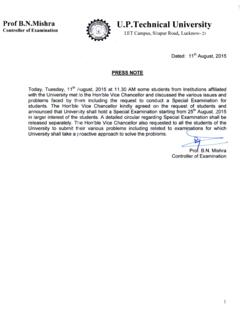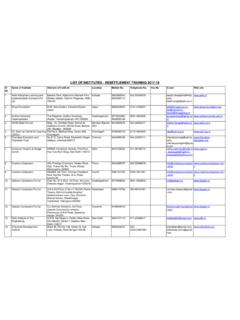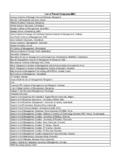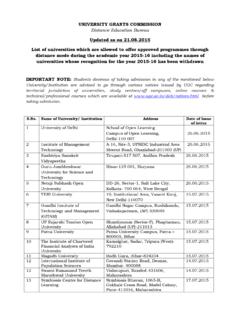Transcription of Chapter 6. Indicator Development and the Planning …
1 85 Chapter 6. Indicator Development and the Planning Cycle6 Indicator Development ANDTHE Planning CYCLEIn this Chapter , procedural issues related to the Development of indicators inthe Planning cycle are discussed. Examples are given of how indicators havebeen used in identifying and analyzing issues, in action Planning and in theimplementation, monitoring and evaluation of intersectoral OF STAKEHOLDERSS takeholders should be engaged at an early stage of Planning in order to promotewider ownership of indicators that are important at all stages of policy-making. Theprocess of Indicator Development has itself proved to be an effective way of ensuringpublic participation in sustainable Development Planning . Communities and non-governmental organizations often have a major stake in developing indicators, notonly for their own activities but also for ensuring that policies are implemented andthat governments and other partners meet their obligations and remain is normally most productive where communities and governments do theirplanning in community-based organizations and non-governmental organizations have usedindicators in funding applications, for example in establishing their bona fides,demonstrating their capacity to monitor and analyze, and showing their organizationalsuccess, responsiveness and accountability (32).
2 In Canada, a sustainable communityindicators programme was developed to assist communities in developing and usingindicators to measure their progress towards sustainability. Software has beendeveloped to help communities select, create and use indicators for monitoring andreporting on local sustainability, to promote the use of comparable indictors, bothlocally and at the national level, and to exchange indicators and related data withother communities (46).In the Development of indicators, various levels of participation may be achieved inthe approaches chosen by the authority or community. These may include: a large working group to consider all the chosen indicators, with additionalexpertise in data gathering from the most appropriate sector choosing specific issue-based indicators and working in issue/sector workinggroups examining linkages between indicators across broad groupings andHealth in Sustainable Development Planning : The Role of Indicators86encouraging different sectors to work together, and working with various community groups and individuals to tackle differentissues independently, canvassing responses from constituents, poolingresults to form an overall picture and reporting back to the authority.
3 (47).The nature of the issues addressed and the types of indicators required will determinehow the partnership model highlighted in Chapter 5 could best be adapted or usedfor developing IDENTIFICATION AND ANALYSISAs discussed earlier, adequate information is often not available to support decision-making and action based on the systematic identification of problems and assessmentof priorities. Much experience has been gained from the national environment andhealth action Planning process referred to in the previous Chapter . The assessmentsof needs that serve as a basis for the plans, while far from perfect, have led to a betterunderstanding of the nature and causes of environment and health problems in specificcountries. Nevertheless, a number of weaknesses have been revealed, for example: Gaps in data availability and quality Difficulty in detecting trends (geographical and temporal) Difficulty in disaggregating data Poor linkages of health and environmental data and sectoral data Emphasis on symptoms rather than on causes of problems Little focus on analysis of management structures and capacity Lack of clarity in priority-setting processesThese apply to developing countries as well as to industrialized countries.
4 Identificationof issues and problems, assessment of needs and setting of priorities for thedevelopment of action plans are important areas in which indicators have a key roleto play. Problems and issues should be defined in both qualitative and quantitativeterms, and sectoral responsibilities should be highlighted. Sometimes a data-drivenapproach is used, in which prime consideration is given to issues that are measureableby existing means, while in other cases a more integrated approach is adopted,combining data and measurements with an intuitive process based on what peopleconsider to be important (55).The analysis of needs and the priority-setting process thus involves both the views ofthe communities involved (which fully express the local perception of the problemsand issues) and a technical assessment based, for example, on available health statisticsand known epidemiological links between health status and environmental and socialconditions.
5 A variety of methods and techniques can be used to engage partners in theidentification of issues, Development of indicators and data collection for 6. Indicator Development and the Planning CycleThese include community meetings, fora, focus group discussions and health and environmental issues for which indicators are needed naturallydiffer from one place to another and depend partly on the priorities and on the capacityfor data collection and analysis in a country or community. Priorities may also changeover time, particularly as different stakeholders with changing perceptions of problemsbecome involved in the process, necessitating a certain amount of flexibility in theselection of PERCEPTIONS OF SUSTAINABLE Development INLANCASHIRE, UNITED KINGDOML ancashire County Council commissioned the Lancaster University Centre for theStudy of Environmental Change to carry out a carefully targeted consultation on itsbehalf.
6 After some background research, eight focus groups were selected to representwidely varying sections of the community which were not already active in theconsultative process. These were young men on training schemes, Asian women,mothers with young children, unemployed men, retired people, rural professionals,middle-aged working-class women and young professionals. The groups were selectedfrom different parts of the county and met twice for 2-hour sessions, which werefacilitated and recorded for later discussions focused on the following issues: identification with place current concerns and anxieties perceptions of the quality of life and identification of those responsible for it feelings about sustainability, the environment and results revealed anxieties about employment, crime, social cohesion and pollutionand a widespread feeling of powerlessness in the face of these problems.
7 Many of thepersonal concerns expressed were not quantifiable and thus not easily amenable toan indicators approach. Only two individuals in all eight groups were familiar with theterm sustainable Development , but the concept received support when it was explainedto the appeared to be strong identification with place in most of the groups, andenvironmental concerns were expressed, mainly in relation to local problems such asthe state of local beaches or traffic and industrial pollution. Action to address theseproblems was impeded by a widespread cynicism and mistrust of public institutions(including local government). In addition, many members of the focus groups doubtedthe willingness of their local authority to bring about real improvements in the qualityof people s lives. This in itself is likely to have important implications for future approachesto public participation in Lancashire, and indeed elsewhere.
8 On this basis, however, theindicators process itself could help to restore trust on an open-ended basis. Source: Local Government Management Board, United Kingdom (47)Health in Sustainable Development Planning : The Role of Indicators88 Development OF A SET OF COMMON INDICATORS OFLOCAL ENVIRONMENTAL HEALTH CONDITIONSIN LUCKNOW AND CALCUTTA, INDIAA project to develop local environmental and health indicators in the cities of Lucknowand Calcutta, India, incorporated the use of innovative techniques such as photography,mapping and drawing as well as community discussions in the selection of local healthand environmental indicators. The indicators were developed by members of severalcommunities who used various qualitative methods adapted to suit each setting. Thecommon methods included discussions at household level, mainly with women,comprising questions about how they would like to see their environment improved,followed by discussion of the factors that would help or hinder their improvement.
9 InLucknow, photography was used by members of the communities to document existingproblems and to show desired environments. Many of the concerns raised at thisstage related to environmental services and especially to water, sanitation and solid-waste management. The photographs, maps and drawings were then used to stimulatediscussion in larger group meetings, where the idea of indicators was Lucknow, residents were asked to imagine the position of service planners and todecide what factors should be monitored, while in Calcutta, residents were asked todecide what environmental factors should be measured. Perhaps as a result of thisdifference, the range of indicators developed in Calcutta was much broader than thatdeveloped in Lucknow. Although the indicators generally varied by settlement, agecategory, sex and socioeconomic group, a common set of indicators emerged acrosssix neighbourhoods in the two addition to the common indicators, a wide range of site-specific indicators wasselected in each of the study sites.
10 These reflected concerns about street lighting,indoor air pollution, pests and the social environment of the neighbourhood. Whereasoutdoor air pollution was not a significant concern in any of the neighbourhoods,indoor air pollution, mainly related to cooking stoves, was a source of anxiety. Many ofthe community indicators involved behaviour, such as the way in which residentsdisposed of their solid waste, as well as service coverage (78).These patterns of selection of common and site-specific environmental and healthindicators across neighbourhoods and cities have implications for the large-scale useof indicators internationally and regionally. The study confirmed that residents prioritiescan be ascertained and expressed as a set of indicators, and the residents felt thatthey were playing a useful role by identifying and advocating action to improve Identified Percentage of households with individual piped water connections Percentage of households with access to sanitary latrines (temporary or permanent)(cont d)89 Chapter 6.















